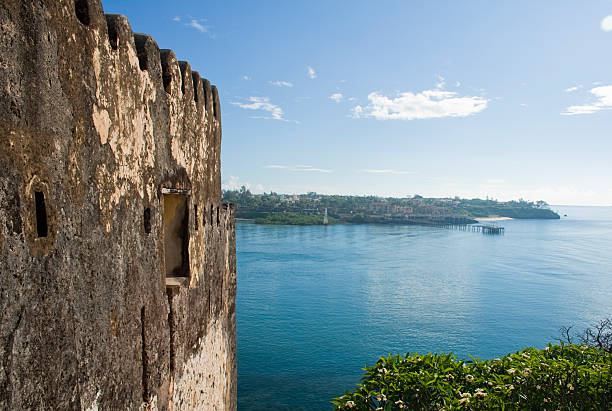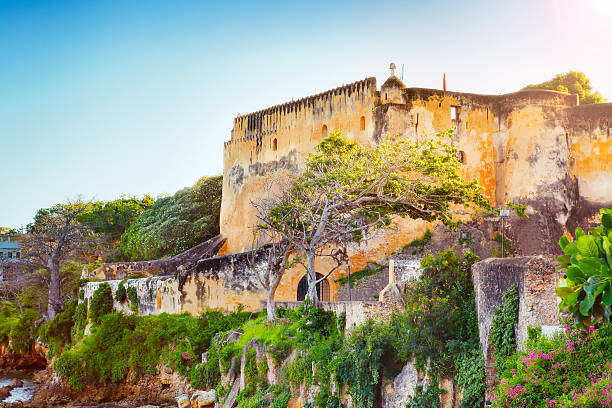Fort Jesus, located in Mombasa, Kenya, stands as an iconic historical site that seamlessly intertwines the rich tapestry of the region’s past. Built in the 16th century by the Portuguese, this fortress has witnessed centuries of maritime trade, colonial struggles, and cultural exchanges, making it a captivating destination for history enthusiasts and curious travelers alike.The fortress’s strategic location at the entrance of the Old Port of Mombasa reflects its original purpose – to safeguard Portuguese interests in East Africa. Commissioned by King Philip I in 1593 and designed by ,the Italian architect, Giovanni Battista Cairati, Fort Jesus has endured a tumultuous history that mirrors the ebb and flow of power in the region.One of the most compelling aspects of Fort Jesus is its architectural significance. The fortress features a blend of European, Arabic, and Swahili influences, a testament to the diverse cultural currents that swept through the East African coast. The imposing walls, designed for both defense and aesthetic appeal, showcase the military prowess of the Portuguese, yet are adorned with intricate details reflecting the artistry of the Swahili and Arabic craftsmen who contributed to its construction.Upon entering the fortress, visitors are transported back in time as they explore the various chambers, courtyards, and dungeons. The layout is a labyrinthine marvel, reflecting the need for both functionality and security. The Chapel, with its simple yet elegant design, exemplifies the religious diversity of the early occupants, as the Portuguese sought to spread Christianity in the region.The interior of Fort Jesus provides a captivating glimpse into the lives of those who lived and worked within its walls. The Omani House, constructed during the Omani occupation in the 18th century, stands as a testament to the changing tides of power in the region. It offers a window into the cultural and architectural shifts that occurred as the fort passed from the hands of the Portuguese to the Omani Arabs.The Museum within the fort is a treasure trove of artifacts, offering a comprehensive narrative of the region’s history. From maritime trade items to weaponry and archaeological finds, the exhibits bring to life the various epochs that shaped Mombasa. Visitors can trace the evolution of the Swahili Coast, from the bustling trade routes that connected East Africa to the Arabian Peninsula and beyond to the struggles for control between European powers.The Well, a crucial water source for the fort’s occupants, is an engineering marvel that attests to the foresight of its builders. Its design ensured a steady supply of fresh water during times of siege, underscoring the strategic acumen of those who planned the fortress. As visitors descend into the dark chambers of the well, they can almost feel the weight of history pressing down upon them.Fort Jesus has withstood not only the ravages of time but also the tides of conflict that swept across the East African coast. The Siege of Fort Jesus in 1696, led by the Omani Arabs, is a pivotal moment etched in the fortress’s history. The scars of cannonball impacts on the walls and the restored battlements serve as poignant reminders of the relentless struggle for dominance in the region.Beyond its military significance, Fort Jesus played a crucial role in the transcontinental exchange of cultures. The Swahili architecture and the intricate carvings found throughout the fortress bear witness to the fusion of European, Arab, and local influences. This cross-cultural exchange is vividly displayed in the architecture, reflecting the intermingling of traditions and ideas that defined the Swahili Coast.Fort Jesus is not merely a static relic of the past; it is a living testament to the resilience and adaptability of the people who called it home. The open-air amphitheater within the fort hosts cultural events and performances, bringing the site to life with the vibrant energy of contemporary Mombasa. This dynamic interaction between the ancient and the modern adds an extra layer of significance to the fort, making it more than just a historical monument.The fort’s strategic location overlooking the Indian Ocean provides breathtaking panoramic views that evoke a sense of awe and contemplation. From its vantage point, visitors can envision the myriad ships that once navigated the waters, laden with spices, textiles, and precious goods. The sea breeze carries whispers of the past, echoing the tales of sailors, traders, and conquerors who left their mark on this coastal stronghold.Fort Jesus, perched on the coral cliffs of Mombasa, Kenya, is a living testament to the intricate dance of cultures and powers that have shaped the East African coast. As one delves deeper into the historical layers of this fortress, the story unfolds with increasing complexity and nuance.The fort’s construction by the Portuguese in the late 16th century was a response to the intense competition for control over the lucrative spice trade routes. The imposing structure not only served as a military stronghold but also as a symbol of European dominance in the region. The imposing bastions and ramparts, designed to withstand naval attacks, underscore the strategic importance of Fort Jesus in safeguarding Portuguese interests.However, the Portuguese dominance was not to last. The Omani Arabs, seizing the fort in 1698 after a prolonged siege, heralded a new chapter in its history. Under Omani rule, Fort Jesus underwent modifications, reflecting the architectural preferences and cultural nuances of its new occupants. The Omani House within the fort, with its distinctive Omani arches and layout, is a tangible reminder of this period.The historical narrative embedded in Fort Jesus extends beyond military conquests and architectural evolution. It is a repository of stories about the individuals who lived within its confines. The barracks, officer’s quarters, and living spaces provide insights into the daily lives of soldiers, merchants, and inhabitants who sought refuge within the fortress during times of conflict.Exploring the museum within Fort Jesus reveals a curated collection of artifacts that illuminate the maritime history of the region. From navigational instruments to trade goods and personal belongings, each item contributes to a comprehensive understanding of the bustling commercial activities that once flourished on the East African coast. The museum offers a chronological journey through the centuries, showcasing the diverse influences that have shaped Mombasa’s identity.The significance of Fort Jesus is not confined to its physical structure; it extends into the intangible realm of cultural exchange. The fusion of European, Arab, and local Swahili influences is evident in the architectural details, carvings, and inscriptions throughout the fortress. This harmonious blending of diverse elements reflects the adaptability and openness of the coastal communities to external influences, creating a unique cultural mosaic.The Chapel of Fort Jesus is a poignant space that encapsulates the religious dimension of its history. The remnants of religious paintings and inscriptions, along with the simple yet evocative architecture, bear witness to the spiritual practices of those who sought solace within the fortress. The chapel’s role in shaping the religious landscape of the region adds another layer of complexity to the multifaceted history of Fort Jesus.While the fort has weathered centuries of storms and conflicts, its preservation and restoration efforts have ensured that its historical legacy endures. The meticulous restoration of the battlements, the well, and other key features allows visitors to experience the fort in a state that closely resembles its original grandeur. Preservation initiatives not only safeguard the physical structure but also contribute to the ongoing narrative of cultural heritage in Mombasa.Fort Jesus is not frozen in time; it serves as a dynamic space for cultural events, exhibitions, and educational programs. The open-air amphitheater within the fortress walls becomes a stage for performances that celebrate the region’s rich artistic traditions. This blending of the ancient with the contemporary breathes life into the historical site, making it relevant and engaging for a diverse audience.


